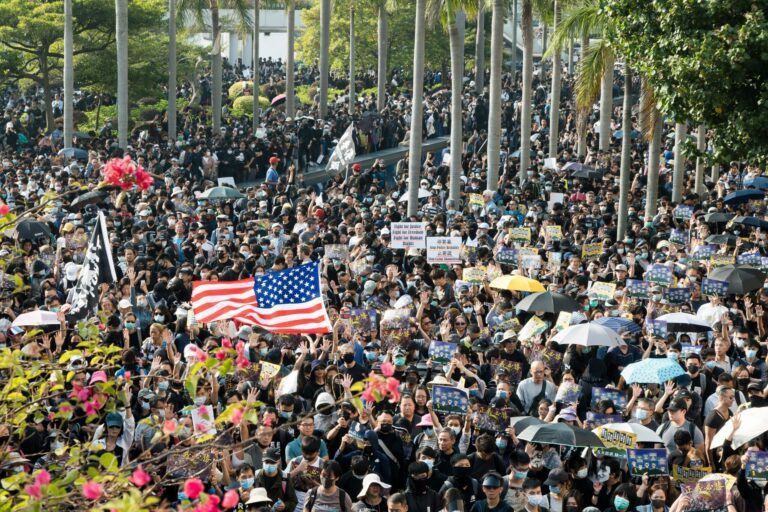On Presidents Day, February 17, 2025, a wave of protests swept across the United States, unified under the slogan “No Kings on Presidents Day.” Organized by the 50501 movement, demonstrators took to the streets from New York to Los Angeles, gathering outside courthouses, federal buildings, and city halls to voice concerns about the increasing concentration of power in the hands of the presidency. The protests highlighted fears that the nation was heading toward a more authoritarian form of governance, driven by a dangerous erosion of democratic checks and balances.
Challenging the Concentration of Executive Power
This nationwide protest was not tied to a single political figure or party. Instead, it reflected widespread alarm about the growing centralization of executive power in the U.S. political system. While the protest’s criticism was particularly sharp against the Trump administration, organizers made it clear that the issue was much larger than any one presidency. They pointed to an ongoing trend in which the balance of power among the three branches of government—executive, legislative, and judicial—has shifted toward the executive, sparking concerns about the weakening of democratic institutions and principles.
The 50501 movement’s organizers framed Presidents Day as a day meant to celebrate accountability rather than unrestrained authority. The phrase “No Kings” was a deliberate critique of the increasing veneration of political leaders, signaling growing fears of a shift toward autocratic rule. Protesters contended that American democracy was at risk as leaders began to adopt a more crown-like, unchecked style of governance.
Defending Civil Rights and Liberties
Central to the protests was a vehement defense of civil liberties, particularly those guaranteed by the U.S. Constitution. Demonstrators voiced strong opposition to policies they believed undermined fundamental freedoms, including attempts to restrict press freedom, limit protest rights, and circumvent legislative oversight. For many of the protesters, these actions represented a systematic erosion of the very principles that define American democracy.
The gatherings featured impassioned speeches and powerful chants, many of which focused on the idea that leaders must be held accountable and must not undermine the rights of individuals. Protesters called for a recommitment to the Constitution, emphasizing that democratic governance is rooted in the protection of freedoms such as freedom of speech, freedom of assembly, and the right to a fair trial. In this climate, they insisted that no leader should be allowed to erode these protections for their own benefit.
Voices of Protest Across the Country
The protests featured a wide array of voices. One notable speaker, a protester in San Francisco, captured the essence of the movement’s message, stating, “We are here to remind our leaders that power belongs to the people, not to kings.” This sentiment echoed throughout the nation as demonstrators gathered in cities from coast to coast, reinforcing the idea that the presidency should remain accountable to the people, not become an office where personal power is unchecked and unchallenged.
The protest was not only a critique of specific policies but a broader call for the restoration of democratic norms and accountability within the U.S. government. Demonstrators, from various ideological backgrounds, stood together, united by a shared commitment to the Constitution and the belief that no leader should be above the law.
A Call for Continued Civic Engagement
The 50501 movement positioned this protest as part of a longer-term effort to safeguard American democracy. Organizers made it clear that their activism was not merely a response to one leader or one moment in history, but a continuous effort to preserve the democratic foundations of the nation. They argued that a vigilant, engaged citizenry is essential in preventing the drift toward authoritarianism, ensuring that American governance remains rooted in democratic values rather than autocratic rule.
This protest’s cross-partisan unity set it apart, bringing together a broad coalition of people who may not agree on every issue but who are united by the belief that power must remain in the hands of the people. Rather than calling for specific reforms, the movement urged for an ongoing commitment to civic engagement, emphasizing that the defense of liberty and justice is a collective, ongoing effort.
Looking Toward the Future
As the demonstrations came to a close, the 50501 movement vowed to continue its fight for systemic reform. Protesters were encouraged to stay active, informed, and ready to hold public officials accountable. The “No Kings on Presidents Day” protest may have been a single event, but organizers made it clear that it was just the beginning of a larger, sustained movement to rein in executive power and restore democratic governance across the United States. For them, the struggle to preserve the republic is far from over, and the effort to ensure that the presidency remains an office of accountability rather than unchecked power is only gaining momentum.


